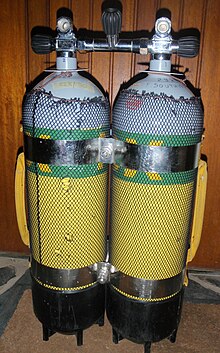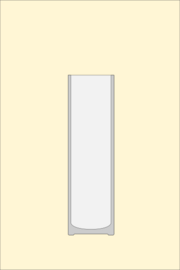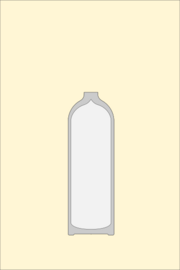
A | B | C | D | E | F | G | H | CH | I | J | K | L | M | N | O | P | Q | R | S | T | U | V | W | X | Y | Z | 0 | 1 | 2 | 3 | 4 | 5 | 6 | 7 | 8 | 9
 Diving cylinders to be filled at a diving air compressor station | |
| Other names | Scuba tank |
|---|---|
| Uses | Breathing gas supply for scuba or surface-supplied divers |
A diving cylinder or diving gas cylinder is a gas cylinder used to store and transport high pressure gas used in diving operations. This may be breathing gas used with a scuba set, in which case the cylinder may also be referred to as a scuba cylinder, scuba tank or diving tank. When used for an emergency gas supply for surface supplied diving or scuba, it may be referred to as a bailout cylinder or bailout bottle. It may also be used for surface-supplied diving or as decompression gas . A diving cylinder may also be used to supply inflation gas for a dry suit or buoyancy compensator. Cylinders provide gas to the diver through the demand valve of a diving regulator or the breathing loop of a diving rebreather.
Diving cylinders are usually manufactured from aluminium or steel alloys, and when used on a scuba set are normally fitted with one of two common types of cylinder valve for filling and connection to the regulator. Other accessories such as manifolds, cylinder bands, protective nets and boots and carrying handles may be provided. Various configurations of harness may be used by the diver to carry a cylinder or cylinders while diving, depending on the application. Cylinders used for scuba typically have an internal volume (known as water capacity) of between 3 and 18 litres (0.11 and 0.64 cu ft) and a maximum working pressure rating from 184 to 300 bars (2,670 to 4,350 psi). Cylinders are also available in smaller sizes, such as 0.5, 1.5 and 2 litres, however these are usually used for purposes such as inflation of surface marker buoys, dry suits and buoyancy compensators rather than breathing. Scuba divers may dive with a single cylinder, a pair of similar cylinders, or a main cylinder and a smaller "pony" cylinder, carried on the diver's back or clipped onto the harness at the side. Paired cylinders may be manifolded together or independent. In technical diving, more than two scuba cylinders may be needed.
When pressurised, the gas is compressed up to several hundred times atmospheric pressure. The selection of an appropriate set of diving cylinders for a diving operation is based on the amount of gas required to safely complete the dive. Diving cylinders are most commonly filled with air, but because the main components of air can cause problems when breathed underwater at higher ambient pressure, divers may choose to breathe from cylinders filled with mixtures of gases other than air. Many jurisdictions have regulations that govern the filling, recording of contents, and labelling for diving cylinders. Periodic testing and inspection of diving cylinders is often obligatory to ensure the safety of operators of filling stations. Pressurised diving cylinders are considered dangerous goods for commercial transportation, and regional and international standards for colouring and labelling may also apply.
Terminology
The term "diving cylinder" tends to be used by gas equipment engineers, manufacturers, support professionals, and divers speaking British English. "Scuba tank" or "diving tank" is more often used colloquially by non-professionals and native speakers of American English. The term "oxygen tank" is commonly used by non-divers; however, this is a misnomer since these cylinders typically contain (compressed atmospheric) breathing air, or an oxygen-enriched air mix. They rarely contain pure oxygen, except when used for rebreather diving, shallow decompression stops in technical diving or for in-water oxygen recompression therapy. Breathing pure oxygen at depths greater than 6 metres (20 ft) can result in oxygen toxicity.[1]
Diving cylinders have also been referred to as bottles or flasks, usually preceded with the word scuba, diving, air,[2] or bailout. Cylinders may also be called aqualungs, a genericized trademark derived from the Aqua-lung equipment made by the Aqua Lung/La Spirotechnique company,[3] although that is more properly applied to an open circuit scuba set or open circuit diving regulator.
Diving cylinders may also be specified by their application, as in bailout cylinders, stage cylinders, decocompression (deco) cylinders, sidemount cylinders, pony cylinders, suit inflation cylinders, etc. The same cylinder, rigged in the same way, may be used as a bailout cylinder, a decompression cylinder or a stage cylinder.[4]
Parts

The functional diving cylinder consists of a pressure vessel and a cylinder valve. There are usually one or more optional accessories depending on the specific application.
The pressure vessel
The pressure vessel is a seamless cylinder normally made of cold-extruded aluminium or forged steel.[5] Filament wound composite cylinders are used in fire fighting breathing apparatus and oxygen first aid equipment because of their low weight, but are rarely used for diving, due to their high positive buoyancy. They are occasionally used when portability for accessing the dive site is critical, such as in cave diving.[6][7] Composite cylinders certified to ISO-11119-2 or ISO-11119-3 may only be used for underwater applications if they are manufactured in accordance with the requirements for underwater use and are marked "UW".[8] The pressure vessel comprises a cylindrical section of even wall thickness, with a thicker base at one end, and domed shoulder with a central neck to attach a cylinder valve or manifold at the other end.
Occasionally other materials may be used. Inconel has been used for non-magnetic and highly corrosion resistant oxygen compatible spherical high-pressure gas containers for the US Navy's Mk-15 and Mk-16 mixed gas rebreathers.
Aluminium
An especially common cylinder provided at tropical dive resorts is the "aluminium-S80" which is an aluminium cylinder design with an internal volume of 0.39 cubic feet (11.0 L) rated to hold a nominal volume of 80 cubic feet (2,300 L) of atmospheric pressure gas at its rated working pressure of 3,000 pounds per square inch (207 bar).[9] Aluminium cylinders are also often used where divers carry many cylinders, such as in technical diving in water which is warm enough that the dive suit does not provide much buoyancy, because the greater buoyancy of aluminium cylinders reduces the amount of extra buoyancy the diver would need to achieve neutral buoyancy. They are also sometimes preferred when carried as "sidemount" or "sling" cylinders as the near neutral buoyancy allows them to hang comfortably along the sides of the diver's body, without disturbing trim, and they can be handed off to another diver or stage dropped with a minimal effect on buoyancy. Most aluminium cylinders are flat bottomed, allowing them to stand upright on a level surface, but some were manufactured with domed bottoms. When in use, the cylinder valve and regulator add mass to the top of the cylinder, so the base tends to be relatively buoyant, and aluminium drop-cylinders tend to rest on the bottom in an inverted position if near neutral buoyancy. For the same reason they tend to hang at an angle when carried as sling cylinders unless constrained.
The aluminium alloys used for diving cylinders are 6061 and 6351. 6351 alloy is subject to sustained load cracking and cylinders manufactured of this alloy should be periodically eddy current tested according to national legislation and manufacturer's recommendations.[10][11] 6351 alloy has been superseded for new manufacture, but many old cylinders are still in service, and are still legal and considered safe if they pass the periodic hydrostatic, visual and eddy current tests required by regulation and as specified by the manufacturer. The number of cylinders that have failed catastrophically is in the order of 50 out of some 50 million manufactured. A larger number have failed the eddy current test and visual inspection of neck threads, or have leaked and been removed from service without harm to anyone.[12]
Aluminium cylinders are usually manufactured by cold extrusion of aluminium billets in a process which first presses the walls and base, then trims the top edge of the cylinder walls, followed by press forming the shoulder and neck. The final structural process is machining the neck outer surface, boring and cutting the neck threads and O-ring groove. The cylinder is then heat-treated, tested and stamped with the required permanent markings.[13] Aluminium diving cylinders commonly have flat bases, which allows them to stand upright on horizontal surfaces, and which are relatively thick to allow for rough treatment and considerable wear. This makes them heavier than they need to be for strength, but the extra weight at the base also helps keep the centre of gravity low which gives better balance in the water and reduces excess buoyancy.
-
Section of die with billet inserted
-
Cold extrusion process
-
Extrusion product before trimming
-
Section after closure of the top end
-
Section showing machined areas of the neck in detail
-
Hydrostatic test
Steel

In cold water diving, where a person wearing a highly buoyant thermally insulating dive suit has a large excess of buoyancy, steel cylinders are often used because they are denser than aluminium cylinders. They also often have a lower mass than aluminium cylinders with the same gas capacity, due to considerably higher material strength, so the use of steel cylinders can result in both a lighter cylinder and less ballast required for the same gas capacity, a two way saving on overall dry weight carried by the diver.[14][15] Steel cylinders are more susceptible than aluminium to external corrosion, particularly in seawater, and may be galvanized or coated with corrosion barrier paints to resist corrosion damage. It is not difficult to monitor external corrosion, and repair the paint when damaged, and steel cylinders which are well maintained have a long service life, often longer than aluminium cylinders, as they are not susceptible to fatigue damage when filled within their safe working pressure limits.
Steel cylinders are manufactured with domed (convex) and dished (concave) bottoms. The dished profile allows them to stand upright on a horizontal surface, and is the standard shape for industrial cylinders. The cylinders used for emergency gas supply on diving bells are often this shape, and commonly have a water capacity of about 50 litres ("J"). Domed bottoms give a larger volume for the same cylinder mass, and are the standard for scuba cylinders up to 18 litres water capacity, though some concave bottomed cylinders have been marketed for scuba.[16][17]
Steel alloys used for dive cylinder manufacture are authorised by the manufacturing standard. For example, the US standard DOT 3AA requires the use of open-hearth, basic oxygen, or electric steel of uniform quality. Approved alloys include 4130X, NE-8630, 9115, 9125, Carbon-boron and Intermediate manganese, with specified constituents, including manganese and carbon, and molybdenum, chromium, boron, nickel or zirconium.[18]
Steel cylinders may be manufactured from steel plate discs, which are cold drawn to a cylindrical cup form, in two or three stages, and generally have a domed base if intended for the scuba market, so they cannot stand up by themselves. After forming the base and side walls, the top of the cylinder is trimmed to length, heated and hot spun to form the shoulder and close the neck. This process thickens the material of the shoulder. The cylinder is heat-treated by quenching and tempering to provide the best strength and toughness. The cylinders are machined to provide the neck thread and o-ring seat (if applicable), then chemically cleaned or shot-blasted inside and out to remove mill-scale. After inspection and hydrostatic testing they are stamped with the required permanent markings, followed by external coating with a corrosion barrier paint or hot dip galvanising and final inspection.[19]
An alternative production method is backward extrusion of a heated steel billet, similar to the cold extrusion process for aluminium cylinders, followed by hot drawing and bottom forming to reduce wall thickness, and trimming of the top edge in preparation for shoulder and neck formation by hot spinning. The other processes are much the same for all production methods.[20]
Cylinder neck
The neck of the cylinder is the part of the end which is shaped as a narrow concentric cylinder, and internally threaded to fit a cylinder valve. There are several standards for neck threads, these include:
- Taper thread (17E),[21] with a 12% taper right hand thread, standard Whitworth 55° form with a pitch of 14 threads per inch (5.5 threads per cm) and pitch diameter at the top thread of the cylinder of 18.036 millimetres (0.71 in). These connections are sealed using thread tape and torqued to between 120 and 150 newton-metres (89 and 111 lbf⋅ft) on steel cylinders, and between 75 and 140 N⋅m (55 and 103 lbf⋅ft) on aluminium cylinders.[22]
This section needs expansion with: Alternative taper thread for small cylinders: British? Historical?. You can help by adding to it. (July 2021) |
Parallel threads are made to several standards:
- M25x2 ISO parallel thread, which is sealed by an O-ring and torqued to 100 to 130 N⋅m (74 to 96 lbf⋅ft) on steel, and 95 to 130 N⋅m (70 to 96 lbf⋅ft) on aluminium cylinders;[22]
- M18x1.5 parallel thread, which is sealed by an O-ring, and torqued to 100 to 130 N⋅m (74 to 96 lbf⋅ft) on steel cylinders, and 85 to 100 N⋅m (63 to 74 lbf⋅ft) on aluminium cylinders;[22]
- 3/4"x14 BSP parallel thread,[23] which has a 55° Whitworth thread form, a pitch diameter of 25.279 millimetres (0.9952 in) and a pitch of 14 threads per inch (1.814 mm);
- 3/4"x14 NGS[24] (NPSM) parallel thread, sealed by an O-ring, torqued to 40 to 50 N⋅m (30 to 37 lbf⋅ft) on aluminium cylinders,[25] which has a 60° thread form, a pitch diameter of 0.9820 to 0.9873 in (24.94 to 25.08 mm), and a pitch of 14 threads per inch (5.5 threads per cm);
- 3/4"x16 UNF, sealed by an O-ring, torqued to 40 to 50 N⋅m (30 to 37 lbf⋅ft) on aluminium cylinders.[25] Zdroj:https://en.wikipedia.org?pojem=Diving_cylinder
Text je dostupný za podmienok Creative Commons Attribution/Share-Alike License 3.0 Unported; prípadne za ďalších podmienok. Podrobnejšie informácie nájdete na stránke Podmienky použitia.
Antropológia
Aplikované vedy
Bibliometria
Dejiny vedy
Encyklopédie
Filozofia vedy
Forenzné vedy
Humanitné vedy
Knižničná veda
Kryogenika
Kryptológia
Kulturológia
Literárna veda
Medzidisciplinárne oblasti
Metódy kvantitatívnej analýzy
Metavedy
Metodika
Text je dostupný za podmienok Creative
Commons Attribution/Share-Alike License 3.0 Unported; prípadne za ďalších
podmienok.
Podrobnejšie informácie nájdete na stránke Podmienky
použitia.
www.astronomia.sk | www.biologia.sk | www.botanika.sk | www.dejiny.sk | www.economy.sk | www.elektrotechnika.sk | www.estetika.sk | www.farmakologia.sk | www.filozofia.sk | Fyzika | www.futurologia.sk | www.genetika.sk | www.chemia.sk | www.lingvistika.sk | www.politologia.sk | www.psychologia.sk | www.sexuologia.sk | www.sociologia.sk | www.veda.sk I www.zoologia.sk






